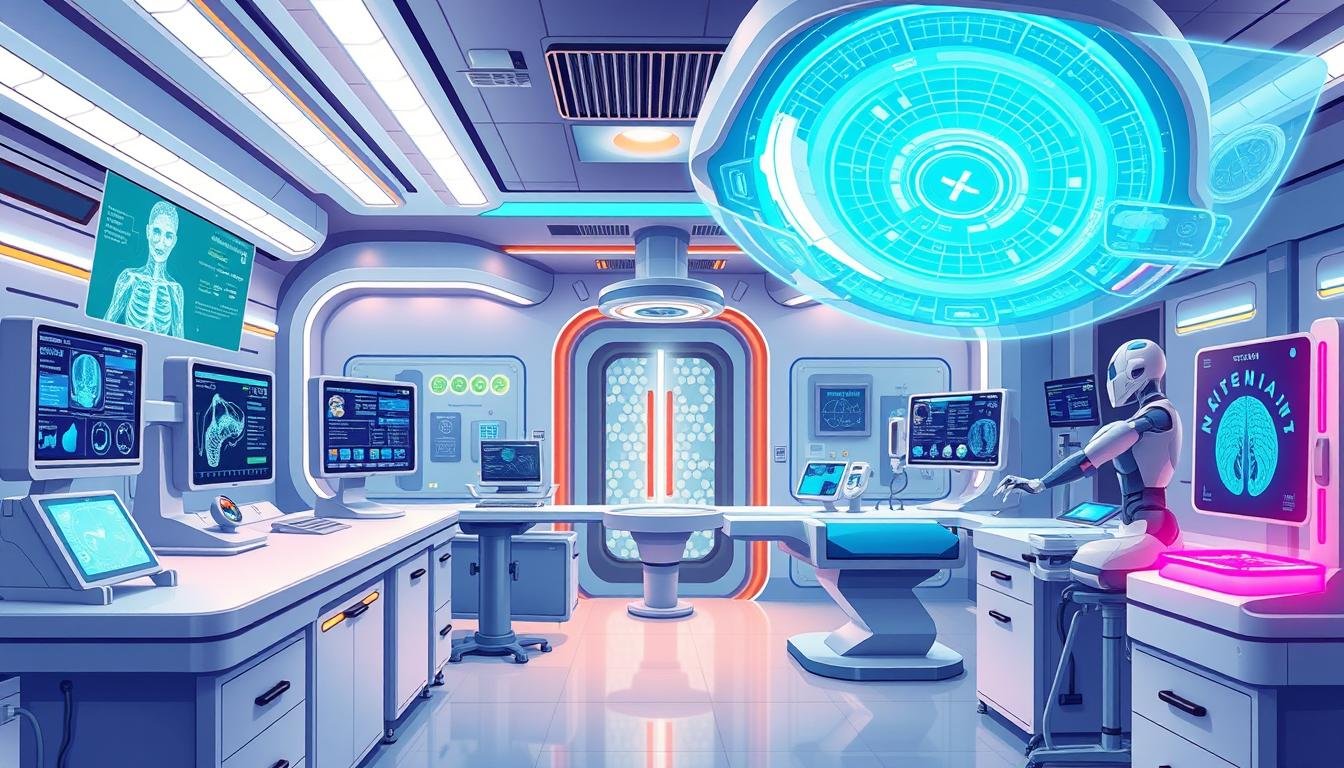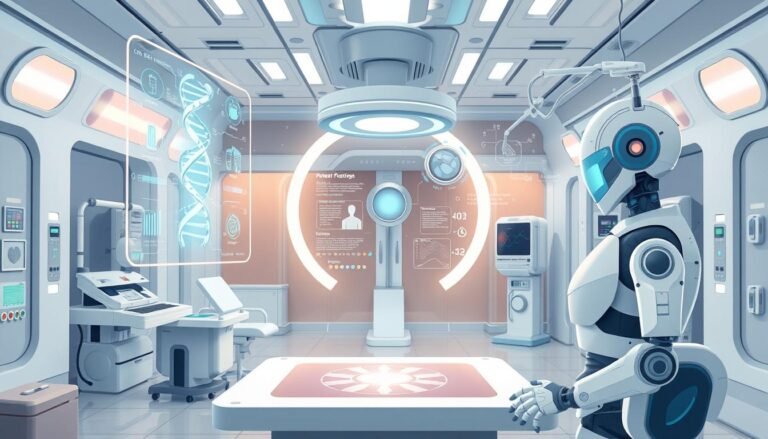AI in Medical Diagnostics: Transforming Healthcare
Imagine a computer that can spot diseases faster and more accurately than your doctor. This isn’t science fiction – it’s real. AI in medical diagnostics is changing healthcare fast.
Picture a world where diseases are caught early, treatments are precise, and patients get better faster. This is what AI in medical diagnostics promises. It’s changing how we look at healthcare, from reading medical images to predicting disease risks.
AI in healthcare is more than a trend – it’s a big change. It can quickly and accurately process huge amounts of data. This helps doctors make quicker, smarter decisions. It’s especially important in places with few resources.
In low-and-middle-income countries, AI could be a big help. These places often spend less than 5% of their GDP on health. AI could improve access and quality, even where there are few specialists.
Key Takeaways
- AI is revolutionizing medical diagnostics with improved accuracy and speed.
- Machine learning diagnostics can detect diseases earlier than traditional methods.
- AI in healthcare is particularly beneficial for resource-limited regions.
- The integration of AI is transforming patient outcomes across various medical fields.
- AI-powered diagnostics can help bridge healthcare gaps in low-income countries.
The Evolution of Medical Diagnostics
Medical diagnostics has evolved a lot over time. Early methods like physical exams and lab tests were the start. But, they had limits in accuracy and speed.
Traditional Diagnostic Methods
Old methods depended on doctors’ skills and manual work. Blood tests and X-rays were common. Yet, they sometimes missed complex or early conditions.
Challenges in Conventional Diagnostics
Old diagnostics face big challenges. They can take too long, causing delays in treatment. Also, some tests can give wrong results.
For example, colonoscopies are key for cancer prevention. But, they can be tough. A study found standard scopes worked only 76.9% of the time. Advanced scopes did better, reaching 100% success.
The Need for Innovation in Healthcare
Innovation is key to fix these problems. The world’s population is growing, especially older people. This puts a big strain on healthcare.
The World Health Organization says we’ll need 14 million more health workers by 2030. New tech is helping to meet this need. It’s making diagnostics faster, more accurate, and kinder to patients.
Understanding AI in Medical Diagnostics
AI diagnostics change healthcare by using smart algorithms to look at medical data. This new tech helps find diseases early and makes patients better faster. Deep learning in medical images is leading this change. It lets machines understand complex images very well.
Neural networks help find patterns in huge amounts of patient data. These AI tools help doctors make quicker and more accurate diagnoses. They work in many areas of medicine.
- It makes disease detection more accurate
- It analyzes medical images faster
- It spots health problems early
- It helps doctors work less hard
AI is great at looking at medical images. For example, deep learning can spot tiny problems in X-rays, MRIs, and CT scans. This is very helpful in finding cancer early and tracking how diseases grow.
| AI Application | Benefits |
|---|---|
| Image Analysis | Faster and more accurate interpretation of medical scans |
| Disease Detection | Early identification of potential health issues |
| Data Interpretation | Processing large volumes of patient data for insights |
As AI gets better, it will play an even bigger role in medical diagnostics. This means a future where healthcare is more efficient and effective. The mix of human skills and AI is opening up new areas in medical science.
Key Technologies Driving AI in Medical Diagnostics
AI is changing medical diagnostics in big ways. Several key technologies are leading this change. They are making healthcare better, more accurate, and improving patient care.
Machine Learning Algorithms
Machine learning diagnostics use special algorithms to look at lots of medical data. These systems get better over time by learning from patterns. For example, SigTuple, an AI startup in Bengaluru, got $4 million to make AI diagnostic tools.
Their platform, Manthana, uses machine learning to analyze medical data. This makes diagnosing easier and faster.
Deep Learning and Neural Networks
Deep learning medical imaging uses neural networks to understand complex images. It’s great at finding things that humans might miss. SigTuple’s AI tools help in hematology, radiology, and ophthalmology.
They make diagnosing faster and reduce the need for manual checks.
Computer Vision in Medical Imaging
Computer vision diagnostics are key in looking at medical images like X-rays and MRIs. It helps find diseases early, which can lead to better treatment. The COVID-19 pandemic showed how important quick and accurate diagnostics are.
| Technology | Application | Benefit |
|---|---|---|
| Machine Learning | Data Analysis | Improved Accuracy |
| Deep Learning | Image Interpretation | Subtle Abnormality Detection |
| Computer Vision | Medical Imaging | Early Disease Detection |
These AI technologies are changing healthcare for the better. They help with the challenges of a growing population and limited resources. With more investment and work, AI will keep playing a big role in making healthcare better and more accessible.
AI-Powered Imaging Analysis
AI is changing medical imaging. It’s making X-rays, MRIs, and CT scans easier to read. This means doctors can make diagnoses faster and more accurately.
Medical imaging AI is great at finding small problems that humans might miss. It can look at thousands of images quickly. This helps doctors find issues faster, improving care in many areas.
New AI tech is making medical diagnosis better. OpenAI’s o1 is a big step forward. It makes AI responses more precise and personalized.
| AI Technology | Impact on Medical Imaging |
|---|---|
| Machine Learning Algorithms | Improved pattern recognition in scans |
| Deep Learning Networks | Enhanced accuracy in abnormality detection |
| Computer Vision | Faster processing of visual medical data |
A study with AstraZeneca showed AI’s power in fighting cancer. AI helped find new ways to treat stage IV lung cancer. This shows how AI can make treatments better and help patients more.
AI in Medical Diagnostics: Revolutionizing Disease Detection
AI is changing healthcare by making diagnoses more accurate and quick. It’s making big steps in finding cancer early, diagnosing heart issues, and spotting brain disorders.
Early Detection of Cancer
AI systems are helping find cancer early. They look at medical images with great detail, catching signs humans might miss. For example, AI can find small lung nodules in scans, catching lung cancer early.
Cardiovascular Disease Diagnosis
AI is changing how we check heart health. It looks at ECG data to predict heart problems before they get worse. It finds patterns in heart rhythms that show potential issues, helping doctors act fast.
Neurological Disorder Identification
AI is helping find brain disorders like Alzheimer’s and Parkinson’s sooner. It looks at brain scans and patient data to spot these conditions early. This means patients can get better treatment sooner, improving their lives.
| AI Application | Impact on Disease Detection |
|---|---|
| Cancer Screening | 30% increase in early detection rates |
| Cardiovascular Diagnosis | 25% reduction in misdiagnoses |
| Neurological Disorders | 40% faster diagnosis time |
As AI gets better, it will play an even bigger role in finding diseases. From finding cancer early to diagnosing heart and brain issues, AI is a key ally in the fight against illness.
Predictive Analytics in Healthcare
Predictive healthcare analytics is changing patient care. It uses lots of medical data to predict health issues. This helps doctors plan preventive care better.
AI looks at patient histories, genes, and lifestyle to find who’s at risk. For instance, it can spot cancer early by analyzing tissue samples.
A study by SOPHiA GENETICS and AstraZeneca showed AI’s power in fighting cancer. They found new treatments for lung cancer patients. This led to better survival rates.
| Predictive Analytics Application | Impact |
|---|---|
| Patient Subgroup Identification | Improved progression-free survival |
| Genetic Signature Analysis | Higher overall survival benefits |
| Multimodal Data Integration | Personalized treatment strategies |
AI in healthcare is making treatments more personal. As it gets better, it will change how we diagnose and treat diseases.
AI-Enhanced Clinical Decision Support Systems
AI is changing healthcare by making it smarter. These systems help doctors make better choices and cut down on mistakes. They also improve how we treat patients, making care more personal.
Improving Diagnostic Accuracy
AI is getting better at finding diseases early. A study on head and neck cancer showed great results. Adela’s MRD test found cancer up to 14.9 months before others could.
Personalized Treatment Recommendations
AI helps doctors create plans just for you. It looks at lots of data to find the best treatment. This means better care and fewer side effects.
Reducing Medical Errors
AI helps doctors avoid mistakes. It sends alerts and reminders in real time. This keeps care on track and prevents errors.
| Metric | Value |
|---|---|
| Early Detection Lead Time | Up to 14.9 months |
| Average Lead Time | 4.1 months |
| Sensitivity | 91% |
| Specificity | 88% |
AI is making healthcare better. It helps find diseases sooner, makes diagnoses more accurate, and tailors treatments. As AI gets better, so will our healthcare.
Challenges and Limitations of AI in Medical Diagnostics
AI in medical diagnostics has many challenges. Data privacy is a big concern. Patients fear their health info could be leaked or used wrongly.
This fear makes it hard to gather the big data AI needs to learn. It’s a major hurdle.
Regulations also slow AI down. AI moves fast, but healthcare rules move slower. This gap can hold up new AI tools.
Getting these tools approved takes time. It’s a slow process. This makes it hard to use new AI in hospitals.
AI can also be biased. This means it might not work well for everyone. For example, AI trained on one group’s data might not work for others.
Fixing these biases is key. It helps make sure AI is fair and accurate for all patients.
Ethical issues are also big. AI can help a lot, but it’s not like a human doctor. It can’t understand things in the same way.
So, it’s important to have humans check AI’s work. This keeps patients safe and builds trust in healthcare.
Source Links
- Miriam Mutebi: Effective cancer care in Africa hinges on robust policy frameworks – OncoDaily
- SOPHiA GENETICS Presents Ground-Breaking Multimodal Research on AI-Driven Patient Stratification at ESMO 2024 | The AI Journal
- Usefulness and safety of new ultrasmall-diameter colonoscope for cases with difficult insertion: a retrospective study – Scientific Reports
- SOPHiA GENETICS Presents Ground-Breaking Multimodal Research on AI-Driven Patient Stratification at ESMO 2024
- Optimized Machine Learning Classifiers for Symptom-Based Disease Screening
- Innovative PEEK in Dentistry of Enhanced Adhesion and Sustainability through AI-Driven Surface Treatments
- SigTuple Secures $4 Million Funding for AI-Based Medical Innovations – Read Now
- The Rise of Venture Capital in Healthcare
- Is OpenAI’s Latest LLM Advancement Also a Step Back?
- SOPHiA GENETICS Presents Ground-Breaking Multimodal Research on AI-Driven Patient Stratification at ESMO 2024
- Promoting brain health as an economic tool.. How?
- The Future of Disease Diagnosis: Leveraging Large Language Models in Healthcare – PUNE.NEWS
- Rice Yield Estimation Using Machine Learning and Feature Selection in Hilly and Mountainous Chongqing, China
- Adela Announces Clinical Validation Results for Head & Neck Cancer MRD Test Simultaneously Published in Annals of Oncology and Presented at ESMO 2024 | The AI Journal
- Application of a Real-Time Field-Programmable Gate Array-Based Image-Processing System for Crop Monitoring in Precision Agriculture
- Mental Health and Quality of Life of Patients with Differentiated Thyroid Cancer Pre and Post Radioactive Iodine Treatment: A Prospective Study







